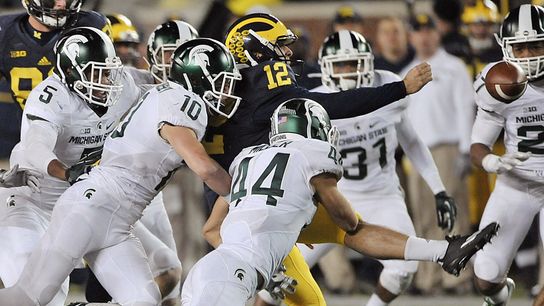Michigan State visits Michigan on Saturday. The last time Sparty went to the Big House, this happened.
#tbt "he has trouble with the snap!" pic.twitter.com/22AA2Zvcmu
— Barstool Spartans (@BarstoolMSU) October 4, 2017
This moment was appreciated immediately for two reasons:
1) For all the absolutely insane endings this sport has produced, both recently (The Kick Six, The Prayer at Jordan-Hare) and in its history, I would put this up there in the improbability category with everything short of the Stanford-Cal game.
2) Sean McDonough's call matches the 0-to-What On Earth Is Happening Right Now tone of the moment perfectly.
That reversal in fortune created winners and losers beyond just Michigan Stadium
While the swift and radical shift from Wolverines 23, Spartans 21 to Spartans 27, Wolverines 23 changed the 2015 season for both teams, it's possible that Blake O'Neill's dropped snap had an even greater impact for a set of teams that wasn't even on the field that day.
Let me explain.
Before we get going, let's take a glance at the 2015 Big Ten East standings.
Now let's assume O'Neill catches that snap, launches the punt and nothing else changes (a risky assumption to be sure, but go with me here).
This is how the top of the Big Ten East standings would've looked.
Ohio State -- 7-1
Michigan -- 7-1
Michigan State -- 6-2



The Spartans would lose 39-38 at Nebraska a few weeks after Ann Arbor but slingshot back forward to a division championship by stunning Ohio State, 17-14 in Columbus, two weeks after that. However, change the game in question from a Spartans win to a Wolverines win and Michigan State's eventual victory at Ohio State still creates a winner-take-all gladiator match between 10-1 (7-0 Big Ten) Michigan and 10-1 (6-1 Big Ten) Ohio State at the Big House.
In what would have been the most hyped regular season game since the 2011 Game of the Century between Alabama and LSU, a supremely talented Ohio State team (we'll get discuss this more in a moment) waltzes over Michigan, 42-13.
https://www.youtube.com/watch?v=OB3-E4O6wkY
In the real world, Michigan State squeaked by Iowa in the Big Ten Championship to advance to the College Football Playoff. We're going to assume Ohio State would do the same.
Ohio State would've been a major threat to win the national championship
Michigan State entered the Playoff as the No. 3 seed despite a strong resume that included wins over No. 15 Oregon and No. 5 Iowa in addition to Ohio State and Michigan. It wouldn't matter, though, as the Spartans were trounced 38-0 by No. 2 Alabama in the Cotton Bowl.
Ohio State would've been a totally different story.
As defending national champions, Ohio State clearly coasted against opponents they didn't feel could beat them. This was a fatal trail, as Michigan State showed. But when these Buckeyes were interested they were as good as anyone -- evidenced by that 29-point blowout of Michigan and a 44-28 demolition of No. 8 Notre Dame in the Fiesta Bowl.
Ohio State had as much or more top-end talent than anyone in college football. Five Buckeyes were selected in the top 20 of that spring's NFL Draft, and three more joined them in 2017. Compare that to Alabama's five first round picks in the 2016-17 NFL Drafts and Clemson's three. (Alabama leads in total picks with 17, to Ohio State's 12 and Clemson's 11. Michigan State, by the way, has seven.)
I'm not going to state unequivocally that No. 3 Ohio State would've taken down No. 2 Alabama and No. 1 Clemson on their way to a second straight national championship. But I'm not going to rule it out, either -- and I am going to rule out a 38-0 snoozer.
No matter the outcome of the 2015 season's playoff, the end result would've been delicious
Let's walk through all three possible scenarios.
1) Alabama beats Ohio State in the Cotton Bowl and goes on to win the national championship (the real world scenario): This would have given Alabama revenge for the previous season's upset loss in the Sugar Bowl, and mirrored the "Urban wins Round 1, but Saban gets his revenge" pattern that played out between the two coaching titans in the 2008 and '09 SEC championship games.
Offseason storylines: Urban is great, but Saban always gets the upper hand. With five national championships to Urban's three, Saban is clearly the superior of the two.
2) Ohio State beats Alabama in the Cotton Bowl, but Clemson beats Ohio State for the national championship: Ohio State would've ended Alabama's season in a CFP semifinal for the second consecutive season, and Urban would have claimed a 3-1 advantage over Saban in championship-level games. However, a loss to Clemson would've marked the second time in three seasons that Ohio Stsate and Urban ended a season in a high-profile loss to Dabo Swinney and the Tigers. Clemson would hold a 4-0 all-time advantage over Ohio State, with all four games coming in major bowl games.
Offseason storylines: Urban has passed Saban for good. Alabama is still clearly very good, but they're no longer in the elite of the elite. The game is starting to pass Saban by. The top of the Big Ten is as good or better than the top of the SEC. Dabo owns Urban. Dabo is the best big-game coach in college football.
3) Ohio State beats Alabama in the Cotton Bowl and beats Clemson in the national championship: This gives Urban his fourth national championship and his first repeat, matching Saban on both fronts. The win hands Ohio State its second national title under Urban Meyer, its third since 2003 -- matching Alabama for the most of the BCS-CFP era -- and its ninth claimed national championship. Ohio State gets the Clemson monkey off its back forever.
Offseason storylines: Urban has equaled and passed Saban forever. Urban is now the king of CFB. Ohio State is the best program of the Championship Era and the most consistent winner of all the blue-bloods.
A butterfly's wings push a punt snap down in Ann Arbor and it creates a hurricane across the pages of college football history
The margins between winning and losing are small in any sport, and the best coaches exploit those margins in their favor more often than not over the long haul. But the margins are downright microscopic in college football, and the Butterfly Effect bleeds over into other games more easily and more clearly than any other sport. Nick Saban already won two national championships in large part due to upsets he had nothing to do with -- Iowa State over Oklahoma State led to Alabama's win over LSU in 2011, and Alabama only survived to beat Notre Dame in 2012 thanks to Kansas State (to Baylor) and Oregon (to Stanford) losing on the same November night. Is it possible this is a third fortuitous bounce that turned into a title? What if Clemson had won the national championship in 2015? Are Deshaun Watson and company driven by the same hunger in 2016?
In the actual reality that actually happened, Blake O'Neill dropped the snap, Jalen Watts-Jackson ran it in, Michigan State won the game and, in turn, the Big Ten, Alabama won the national championship in a bitterly close contest over Clemson, and the sting of that defeat propelled Clemson to score its revenge over Alabama a week later. That chain of events has created its own series of Butterfly Effects that will inspire their own actions and reactions, that will then create their own Butterfly Effects, and on and on it goes.
But at its most basic level, plays like this one are what make college football so much more interesting than any other sport. A punter drops a snap in a mid-October game, and the trajectory of the sport is altered forever.
